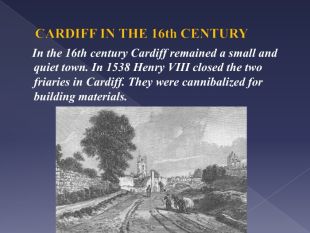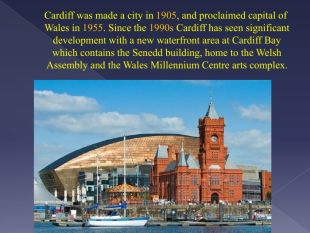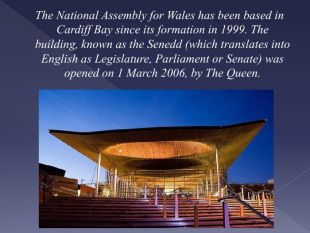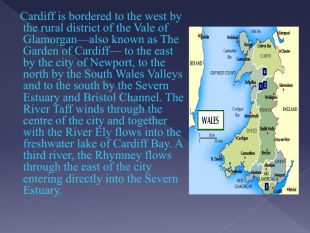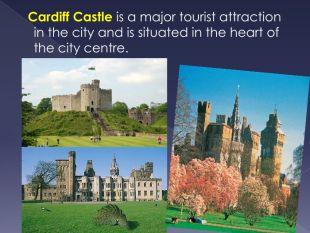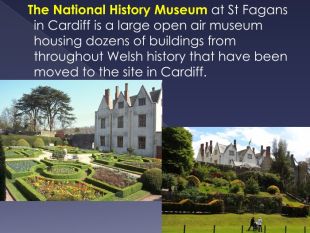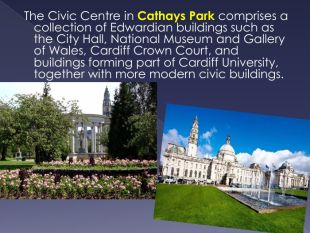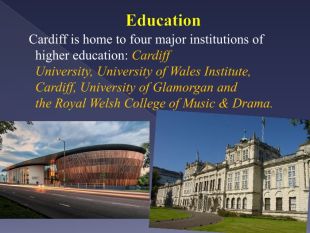Презентація "Cardiff as the capital of Wales".




























THE ROMAN FORT AT CARDIFF Cardiff began as a Roman fort. The Romans invaded Wales about 50 AD and about 55 AD they built a fort on the site of Cardiff. In the late 1st century the fort was reduced in size as Wales was now at peace. However in the mid-3rd century the fort was rebuilt and strengthened to defend South Wales against Irish raiders. Yet in the fourth century Roman civilisation declined. Towards the end of the century the Romans abandoned the fort at Cardiff.
CARDIFF IN THE MIDDLE AGES The town of Cardiff was founded when the Normans conquered Glamorgan. A Norman called Robert Fitz Hamon conquered the area. He built a wooden castle within the walls of the old Roman fort. (The castle was rebuilt in stone in the early 12th century). Soon a little town grew up in the shadow of Cardiff castle. That often happened in the Middle Ages as the castle's garrison provided a market for the goods made by the craftsmen of the town. Cardiff had a population of between 1,500 and 2,000 in the Middle Ages. Towns were very small in those days, especially Welsh towns.
More about castles In Cardiff there were weekly markets. After 1340 Cardiff also had 2 annual fairs. In the Middle Ages the fairs were like markets but they were held only once a year and they lasted a fortnight. Buyers and sellers would come from all over Glamorgan and even further away to attend a Cardiff fair. In Medieval Cardiff there were the same craftsmen you would find in any Medieval town like butchers, bakers, brewers, carpenters and blacksmiths. There were also leather workers like shoemakers and glovers. Medieval Cardiff was also a busy port. Ships were loaded and unloaded at a town quay.
In the early 12th century a wooden palisade was erected around Cardiff to protect it. In the late 13th century this was replaced by a stone wall. Then in the 13th century the friars arrived in Cardiff. Friars were like monks but instead of withdrawing from the world they went out to preach. There were 2 orders of friars in Cardiff. The Dominicans were called black friars because of their black costumes. The Franciscans were known as grey friars because of their grey costumes. Although they have long since disappeared from Cardiff the grey friars live on in the street name Greyfriars Road.
A writer described Tudor Cardiff: 'The river Taff runs near the town walls in the west part of the town and washes the walls but somewhat too hard for part of it is thereby overturned (undermined) and the sea flows to the walls where, at the west angle, is a fair quay to which both ships and boats resort'. Another writer said: 'The River Taff runs under the walls of his honor's castle and from the north part of the town to the south part where there is a fair quay and a safe harbor for shipping'. In the 16th century, for the purpose of collecting customs, the port of Cardiff officially extended from Chepstow to Worms Head. In those days there were many pirates operating from Cardiff often with the connivance of local officials. The navy finally took decisive action to suppress piracy in the early 17th century.
From the late 18th century Wales was transformed by the industrial revolution. At that time increasing amounts of iron were exported from Cardiff. However it was difficult to transport iron to the port by land so in 1794 a canal was built. In 1798 a sea basin was created with a sea lock to allow ships in where they could be loaded or unloaded from barges or from the wharf. In 1796 a writer said of Cardiff: 'The inhabitants of this town and neighborhood carry on a considerable trade to Bristol and send thither great quantities of oats, barley, salt butter and poultry of all kinds and from this town there are not less than 8,780 tons of cast and wrought iron shipped annually to London and other places'.
Origins of the Name. There are two rival theories regarding the precise origins of the name Cardiff or Caerdydd in Welsh. Some believe that “Dydd ” or “Diff” was a corruption of “Taff”, the river on which Cardiff Castle stands, in which case “Cardiff” would mean “the fort on the river Taff” (in Welsh the T mutates to D). A rival theory favours a link with Aulus Didius Gallus who was a Roman governor in the region at the time the fort was established. The name may have originated as Caer Didius – The Fort of Didius.
In 1794, the ironmasters of Merthyr Tydfil opened the Glamorganshire Canal, which linked Merthyr Tydfil with Cardiff for the transport of iron and then later used to transport the huge amounts of coal for export following the opening of the West Bute Dock in 1839 by the 2nd Marquess of Bute. This saw Cardiff become the biggest coal exporting port in the world, resulting in Edward VII granting Cardiff city status. In subsequent years an increasing number of national institutions were located in the city, including the National Museum of Wales, Welsh National War Memorial, and the University of Wales Registry Building
Geography The centre of Cardiff is relatively flat and is bounded by hills on the outskirts to the east, north and west. Its geographic features were influential in its development as the world's largest coal port, most notably its proximity and easy access to the coal fields of the south Wales valleys.
Cardiff is bordered to the west by the rural district of the Vale of Glamorgan—also known as The Garden of Cardiff— to the east by the city of Newport, to the north by the South Wales Valleys and to the south by the Severn Estuary and Bristol Channel. The River Taff winds through the centre of the city and together with the River Ely flows into the freshwater lake of Cardiff Bay. A third river, the Rhymney flows through the east of the city entering directly into the Severn Estuary.
Landmarks and attractions Cardiff has many landmark buildings such as the Millennium Stadium, Pierhead Building and the Senedd, the home of the National Assembly for Wales. However Cardiff is also famous for Cardiff Castle, St David's Hall, Llandaff Cathedral and the Wales Millennium Centre.


про публікацію авторської розробки
Додати розробку









